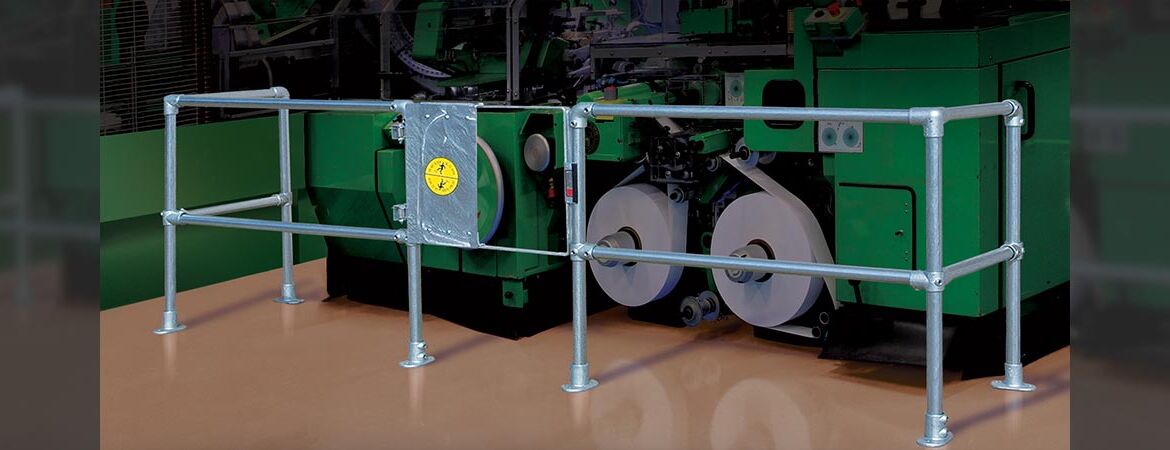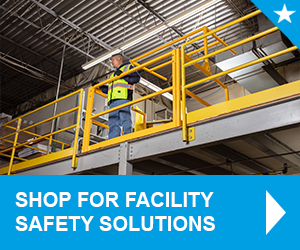
Manufacturing facilities depend on a range of machinery that raise equal concerns for accessibility and protection. Balancing operational and machine guarding needs can be challenging, as it means safety managers must balance production needs with a host of OSHA machine guarding requirements, many of which often overlap with OSHA fall protection standards. While these requirements may seem complex, however, it’s possible to meet most machine guarding requirements with fall protection safety gates and modular rails for machinery.
Inherently Unique Compliance Requirements
Yes, it’s possible to meet a large range of OSHA machine guarding requirements using adaptable modular railing and safety gate designs; however, no two facilities have identical needs. Consult your specific OSHA, state plan, or CCOHS requirements before making significant decisions related to manufacturing facility safety.
This entails verifying that a given safety device was tested according to the standards governing your facility. Such considerations are much easier with the help of leading fall protection manufacturers with a reputation for meeting the widest possible compliance standards, both nationally and internationally.
Modularity: The Key to Overlapping Safety and Technical Requirements
However unique a facility’s requirements, designs like modular rails for machinery can be key to safely and easily meeting complex intersecting regulations. That’s because most manufacturing facilities are continually evolving environments that necessitate:
- Frequent equipment upgrades
- Layout changes
- Regular machine servicing
- The need to protect both workers and equipment
- Dual accessibility and protection needs, even on the same equipment
Adapting to Rapid Workflows
Manufacturing operations also depend on minimal downtime, and the last thing facility owners and safety managers want to contend with is a work-stopping safety issue. However, this doesn’t minimize the need for diligent machine safety measures. Rather, it only raises the bar on fulfilling such machine guarding needs quickly and thoroughly.
Modular Safety Designs for Continually Evolving Layouts
From automation equipment, additive printing, and other cutting-edge solutions only dreamed of a short time ago, modern manufacturing facilities have an increasingly broad range of equipment at their disposal. These are signs of evolving processes, but as operations change, so too must safety equipment.
This isn’t always possible with permanent railing, which can complicate and even stimy workflows with rigid, unalterable designs. More than annoying, such limitations can be outright revenue-crushing for manufacturing facilities.
Modular guardrails, on the other hand, meet needs for facility-wide adaptation without compromising on safety, due to several features:
- Compatibility with a range of midrails, cross members, and vertical posts
- Support for an equally wide range of fall protection safety gates
- The ability to adapt around different types of machinery as facilities evolve
- Simple hand-tool installation, yet with no loss in performance
Beyond Minimum Design Standards
While meeting OSHA machine guarding requirements means considering myriad design specifications (namely OSHA 1910.29[b]), these requirements do not relate to the use of specific products or features. Rather, OSHA sets general design standards, including:
- Force ratings – where top and mid-rails must withstand 200 and 150 lb. (890 and 667 N) of force, respectively, in a downward and outward direction (per subsections [b][4] and [5])
- Guardrail dimensions, covered in subsections (b)(1) through (3), in which:
- The top edge of the top railing must be 42 in. (107 cm) above the walking-working surface, plus or minus 3 in. (8 cm)
- Midrails must be midway between the top edge of the top rail and the walking-working surface below
- Vertical and other intermediate members must leave no more than 19 in. (48 cm) of space within the guardrail structure
From a design standpoint, the takeaway is that regulatory compliance only requires meeting basic dimensional and force-testing requirements. After meeting these standards, facilities and fall protection manufacturers are perfectly free to apply any number of design innovations to facilitate unique work requirements.
Modular railing takes this one step further by empowering facility technicians to construct their own OSHA-compliant machine railing. Given the enormous complexity of machine hazards, it’s practically a necessity.
Rendering Manufacturing Machinery Safe and Accessible
Balancing the need for safety and accessibility depends heavily on accurate hazard detection. OSHA 1910.212 outlines the following general machine guarding requirements (with additional definitions taken from 1910.211) for both operators and employees in the machine area:
- Point of operation on machines “where work is[…] performed upon the material being processed,” including “cutting, shaping, boring, or forming” materials
- Ingoing nip points, aka the “bite” between “two inrunning rolls”
- Rotating parts, which present various crush hazards and are especially prevalent during equipment maintenance
- Flying chips and sparks, an ongoing hazard for metal manufacturing facilities
Further, any such machine requiring guarding requirement may need protection in any of three fundamental areas:
- Points of operation, as described above
- Power transmission devices, which can further invoke design requirements for electrical protective equipment
- Operating controls, which particularly depend on fine-tuning the balance between safety and accessibility
The latter area raises an important point, from section 1910.212(a)(2), “General requirements for machine guards,” which reads:
“The guard shall be such that it does not offer an accident hazard in itself.”
Modular Safety Gates for Equally Safe and Accessible Machinery
In most cases, the most effective way to simultaneously fulfill safety and accessibility requirements is with OSHA-compliant fall protection safety gates. As with modular guardrails, there are many custom safety gate solutions that fulfill unique needs in manufacturing environments:
- Self-closing safety gates, suitable for most simple machine protection requirements while also fulfilling basic fall protection duties when closed
- Extended coverage self-closing safety gates, which further block access to hazardous equipment by virtue of its larger form and multiple midrails
- A full coverage self-closing safety gate, an effective solution for machinery located on elevated platforms where falling object risks are also a concern (as when toeboard or screen requirements become necessary, per OSHA 1910.28[c][1])
Further, most manufacturing facilities present various working-at-height scenarios. With modular fall protection safety gates, the very same type of equipment can meet fall protection requirements for stairways, catwalks, and other elevated spaces.
Safe, Adaptable Machine Protection for Fluid Manufacturing Environments
As manufacturing facilities expand functionality, they depend equally on adaptable and compliant fall protection solutions. We’ve explored just several examples where modular rails for machinery and self-closing gates can ensure your workers’ safety needs and OSHA machine guarding requirements are met.
For over 45 years, Fabenco has helped manufacturers maximize safety, efficiency, and uptime. To learn more about fulfilling machine safety requirements with advanced modular designs, contact us, and speak with our dedicated fall safety experts.





